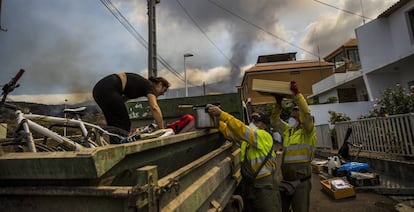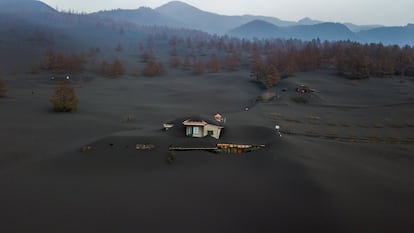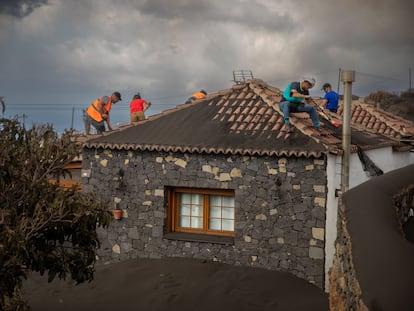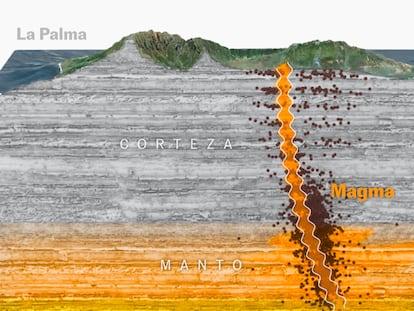La Palma volcano in numbers: €700m in damages, 5,100 quakes and 7,000 evacuated
Two months have now passed since the eruption began, making it the longest to hit the Spanish island since 1712
Today marks two months since the new volcano on the Spanish island of La Palma began to erupt. They have been, according to the president of the island authority, Mariano Hernández Zapata, “the worst” in the recent history of the island. The eruption has been the protagonist of these 61 days in the lives of the nearly 85,000 residents on the Canary Island, located off the northwest coast of Africa. The eruption is now the longest since 1712, when there was a volcano in El Charco, also on La Palma. It is still, however, way off the 2,055 days that the eruption of Timanfaya, on neighboring island Lanzarote, lasted. According to the Volcanology Institute of the Canaries (Involcan), the energy being released is as much as 286.2 terawatts per hour, a figure that’s equivalent to 35.9 times the energy needs of the entire Canary Islands archipelago.
So much of this natural energy has served to destroy man-made constructions on La Palma. Many residents have already lost their homes, while others are waiting anxiously to see if their properties will escape the passing of the lava. Hundreds have lost their jobs while many others may lose theirs in weeks to come. The numbers can’t reflect the entire reality of the situation, but they can help when it comes to describing the magnitude of the tragedy on what is affectionately known as the “Isla Bonita” (the beautiful island).
1,040 hectares covered with lava
When the volcano began to erupt, the whole world looked on with amazement at the natural spectacle. The island residents, however, were aware from the very first moment of the dangers they were facing. By the next morning, the lava had razed a large part of El Paraíso neighborhood in the municipality of El Paso, as well as part of Las Manchas, and was moving downhill at great speed in a southwesterly direction.
“The volcano does what it wants,” María José Blanco, a volcanologist from the National Geographic Institute, has explained on a number of occasions. On its erratic route, the lava has covered El Pedregal, Todoque, Los Campitos and Callejón de la Gata. “My mother doesn’t even have a jacket,” explained Aníbal Díaz on September 24. This forestry engineer and her parents lost everything they had in Las Manchas to the molten rock.
In total, up to Thursday 1,041 hectares of land had been covered by the lava – that’s 1.4% of the total area of La Palma, with a perimeter of 53 kilometers. “The situation is too much…,” the mayor of Los Llanos de Aridane, Noelia García, told EL PAÍS on September 22. “This is very serious, it’s very, very tough.” The lava has also created a new delta in the sea, starting from September 28, with 42.8 hectares of new territory up to now.

Anxiety has been the common currency these past two months. The haphazard behavior of the volcano has destroyed the dreams of many, at a time when it seemed they had escaped the danger. Carlos Déniz is one of these people. He was a cook at a bar on Los Guirres beach, one that was run by his wife, Grecia Motta. On Thursday, the establishment, which opened in 2011, succumbed to the advance of the lava flow that is creating a second delta in the sea: D2, a cold and scientific name.
The widest part of the lava flow expelled from the Cumbre Vieja mountain ridge measures as much as 3,200 meters. As well as this surface area, a further 2.5 kilometers have been declared an exclusion zone by the team of experts monitoring the phenomenon, the Volcano Risk Prevention Plan (Pevolca). The objective is to avoid gases and pyroclasts – rock fragments produced and ejected by the volcano – from affecting the population.
“The volcano has lost energy,” explains the director of the National Geographic Institute, María José Blanco, as well as Carmen López, the director of the Central Geophysics Observatory from the same organization. The reduced effect of the lava is clear for all to see. The explosiveness of the cone, however, is causing constant collapses, which is changing the route of the lava flows. This means that, two months later, there have been as many as 12 different routes for the molten rock, each creating its own path of destruction.

7,000 people evacuated
So far, the eruption has destroyed 1,184 homes according to land registry figures. Those are the dreams of 2,120 people, the number of residents in the exclusion zone according to data from La Palma Cabildo, as the island authority is known. The anxiety, however, is being felt by a total of 7,000 people – the number of residents who have had to be evacuated since 3.13pm on September 19, the moment everything began.
On that Sunday, the Canary Islands’ regional government urgently ordered 5,000 people to abandon their homes. Five days later, a further 350 people were evacuated from Tajuya, Tacande de Abajo and Tacande de Arriba. On October 12, another ordeal began for around 1,200 residents of La Laguna, the neighborhood where, on September 23, King Felipe VI and Queen Letizia of Spain said that they were left “speechless” by what they had witnessed on a visit there.
The Canarian government has prepared two hotels and a number of other facilities for those who have been displaced – but barely 483 residents have made use of them. Luz, 33, is one of them. She lives with her two daughters in two rooms in a hotel in Fuencaliente, located to the south of the island. “I don’t see anything positive in being here,” she complained on October 30. “I would like to be able to rent a house, but I earn €900 a month and the price of rent has shot up, there’s no subsidies for this.” The remainder of the evacuees are doing the best they can in the homes of relatives or friends.

Up to €700m in damages
“We are still in the thick of it,” the regional premier of the Canary Islands, Ángel Víctor Torres, has stated over and over. That is why the actual cost of the damage caused by the volcano continues to rise, minute by minute. Notwithstanding, Torres has sought to estimate the final bill: between €550 and €700 million. This figure would qualify the island for access to the European Union’s solidarity fund: the requirement is damages above 1% of gross domestic product (GDP), some €430 million.
The problems, however, are not limited to people losing their homes or their businesses. Up until now, 66 kilometers of roads have also been damaged. Among them, one is particularly important: the 2.1 kilometers of the LP-2 that have been cut off by the lava. There are just 15 kilometers between Los Llanos de Aridane and Fuencaliente. After the eruption and the blockage of this route, many people are having to travel halfway across the island every day. “Before the volcano, I took 10 minutes to get to work,” explained bus driver Juan José Lorenzo, on October 6. “Now it takes me an hour-and-a-half.”

€345m in aid, hope for islanders
Spanish Prime Minister Pedro Sánchez is planning to visit La Palma on Saturday, making this his seventh visit since September 19. The third time he traveled to the Canary Island after the eruption began the Socialist Party (PSOE) leader announced a “powerful package of measures” that would be destined for the rebuilding of infrastructure as well as the reestablishment of the water supply, investment in employment, housing, agriculture, tourism and a range of tax breaks. The total budget for these policies is €206 million, as he explained that day.
As well as these funds, the Canarian government has allocated €40 million more in spending during this first phase, and a further €10.5 million has been approved by the central government for housing and essential items. The regional executive, meanwhile, will include an extraordinary item in its 2022 budget to begin the rebuilding of the island. What’s more, the Cabildo has received €7.5 million in donations and there is also the promise of more money from Brussels.
But for now, all of this money is just a promise, and the population of La Palma is getting impatient. “We are all waiting,” said Antonio Ríos on November 16. Until the eruption of the volcano, this man – who is originally from Cádiz – was working at a banana-packing plant, and also oversaw two plantations of the fruit. “We are looking at what to do according to the assistance,” he explains. “It’s not normal for them to be taking so long to get things going, the bureaucracy should be more agile.”
85 earthquakes a day
Earth tremors have been a regular feature of the eruption, but the fact that they have been so regular has not stopped the population of La Palma from suffering every time the ground shakes – and it has shaken a great deal in the last two months. Since the eruption began up until November 18, there have been 5,100 tremors on the island, which is 85 a day, according to data from IGN seismologist Ithaiza Domínguez.
Of these, 547 have been below a depth of 20 kilometers. But it’s not just the quantity that is significant, but also their virulence. Sixty-nine of them have measured at least 4 on the Richter scale, and a total of 750 have been felt by the population. “Some of the walls of my house have cracked due to so many tremors,” explained Atenea Aguilar on November 4. She’s a resident of the Villa de Mazo municipality. “The one this morning caused all of the glasses to move.”
Tu suscripción se está usando en otro dispositivo
¿Quieres añadir otro usuario a tu suscripción?
Si continúas leyendo en este dispositivo, no se podrá leer en el otro.
FlechaTu suscripción se está usando en otro dispositivo y solo puedes acceder a EL PAÍS desde un dispositivo a la vez.
Si quieres compartir tu cuenta, cambia tu suscripción a la modalidad Premium, así podrás añadir otro usuario. Cada uno accederá con su propia cuenta de email, lo que os permitirá personalizar vuestra experiencia en EL PAÍS.
¿Tienes una suscripción de empresa? Accede aquí para contratar más cuentas.
En el caso de no saber quién está usando tu cuenta, te recomendamos cambiar tu contraseña aquí.
Si decides continuar compartiendo tu cuenta, este mensaje se mostrará en tu dispositivo y en el de la otra persona que está usando tu cuenta de forma indefinida, afectando a tu experiencia de lectura. Puedes consultar aquí los términos y condiciones de la suscripción digital.
More information
Últimas noticias
Alain Aspect, Nobel laureate in physics: ‘Einstein was so smart that he would have had to recognize quantum entanglement’
Imelda Castro, the woman who wants to rule the cartel battleground of Sinaloa
The new victims of the Republican war on Obamacare: Millions hit by soaring health insurance premiums
A country divided on migrant rights: Some US states expand protections while others restrict them
Most viewed
- David King, chemist: ‘There are scientists studying how to cool the planet; nobody should stop these experiments from happening’
- Reinhard Genzel, Nobel laureate in physics: ‘One-minute videos will never give you the truth’
- Oona Chaplin: ‘I told James Cameron that I was living in a treehouse and starting a permaculture project with a friend’
- Sinaloa Cartel war is taking its toll on Los Chapitos
- Mexico completes its trade shift with the entry into force of tariffs on China and countries without trade agreements











































